 |
セインさん、今日は「人形町 志乃多寿司總本店」を訪ねます。
創業は明治10年(1877)。お寿司といっても握り寿司ではなく、いなり寿司と大阪寿司の専門店です。
初代は広島藩の江戸詰めの藩士で、明治維新でお務めがなくなり、この人形町に「いなり寿司」の屋台を出したのだそうです。明治時代、このあたりには芝居小屋がいくつもあって大変賑わっていた街でしたから、いなり寿司屋台も大ヒットしたのでしょう。そして今も、志乃多寿司の「おいなりさん」や「大阪寿司」は大人気です。
Today we’ll visit the Ningyocho Shinodazushi Sohonten which was founded in 1887. When you think of “sushi,” nigirizushi may come to mind, but this shop specializes in two types of sushi called inarizushi and Osakazushi.
The first generation owner was a samurai from the Hiroshima Domain who was working in Edo, which later became Tokyo. It is said that when he stopped working as a samurai during the Meiji Restoration, he opened an inarizushi stand in Ningyocho. In the Meiji Period (1868 – 1912), there were a number of theater playhouses around this area and it was a bustling town, so the inarizushi stand was a big hit then. Even now, Shinodazushi’s oinarisan and Osakazushi are very popular. |
|
|
 |
■はい。僕も大好きです。
Right, I also love those. |
|
|
|
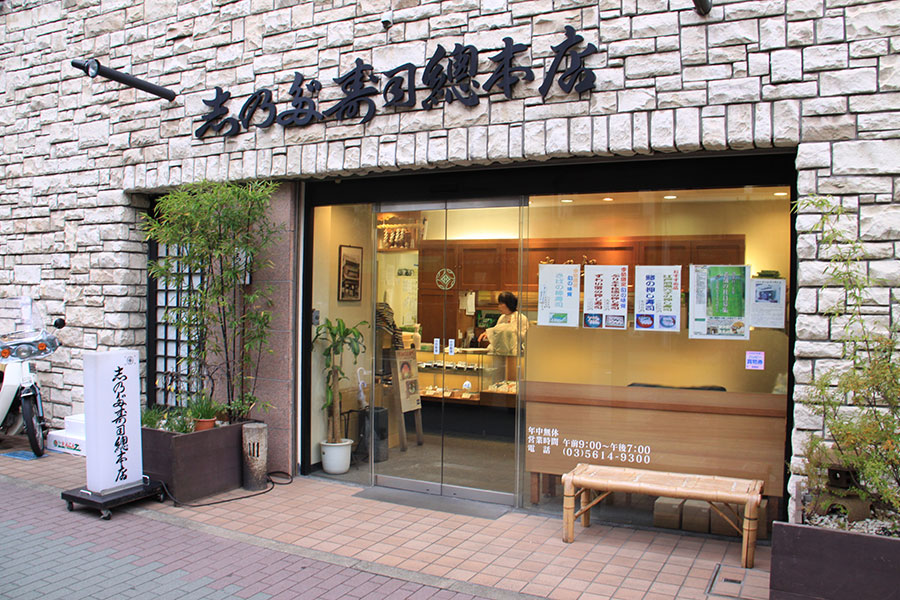
人形町志乃多寿司總本店の外観
[Photo: Ningyocho Shinodazushi Sohonten, exterior] |
|
|
|
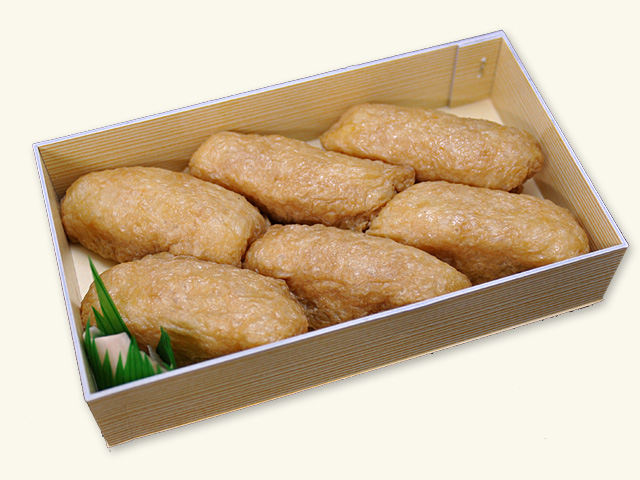
志乃多
[Photo: Shinoda inarizushi] |
|
|
|
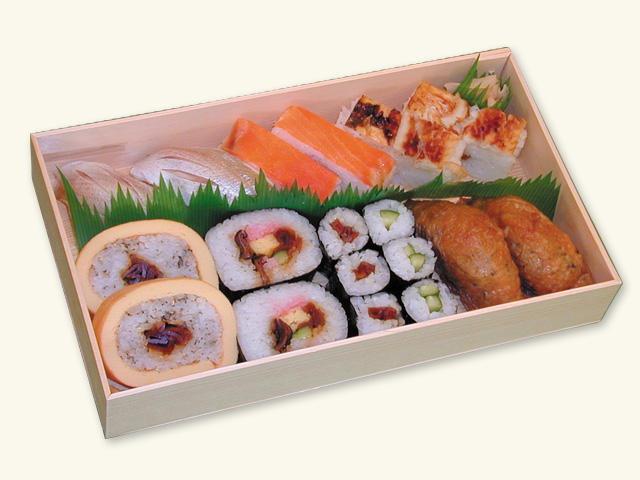
詰合せ
[Photo: Assortment of sushi] |
| (吉益) |
こんにちは。セインさん。志乃多寿司の吉益敬容です。
Hello. I’m Takahiro Yoshimasu, the owner of Shinodazushi. |
|
|
 |
こんにちは、吉益さん。セインです。今日はこの店の「おいなりさん」を食べてからやってきましたが、相変わらずおいしいですね。ご飯とお揚げのバランスがいいからでしょうか。しっかり味がついているのに、しつこくなくて、いくらでも食べられそうです。
この味が、代々のご主人が守り続けてこられた味なんですね?
Hello. I’ve eaten oinarisan from this shop before coming here today, and I have to say that it’s still very delicious. Maybe it’s because of the nice balance between the rice and fried tofu. Even though it has a robust taste, it’s not overly strong, so you can eat lots of it without getting tired of it.
I suppose each generation has maintained this flavor over the generations, right? |
|
|
| (吉益) |
はい。いなり寿司は、創業以来140年余、大きさや作り方もほとんど変えず、手作りにこだわって作っています。
お揚げは、味がしみこみやすいように普通の油揚げよりも薄いものを、長いお付き合いのお豆腐屋さんに頼んで作ってもらったもの。それを大鍋に湧かした湯で茹でて油抜きするところから作業が始まります。でも、あまり油を抜き過ぎてもおいしくないんです。
Yes. Ever since the shop’s establishment 140 years ago, we’ve continued to make it by hand, and the size of the sushi and the way we make it hasn’t changed much since those times.
For the fried tofu, we use something that is thinner and absorbs flavor more easily than the usual kind, which is made by a tofu shop that we’ve had a long association with. We boil the fried tofu in a large pot with water, and then the real work starts with removing the oil. But if you take out too much oil, it won’t be tasty. |
|
|
 |
誰でもできそうに見えて、実は長年の経験が必要な作業なんですね。
That looks like something that anyone can do, but I heard that it actually takes many years of training to do it right. |
|
|
| (吉益) |
はい。ですから、職人が鍋につきっきりになって、様子を見ながらやっています。
Yes, that’s right. Our workers are busy working while constantly attending to the pots and checking on them. |
|
|
|
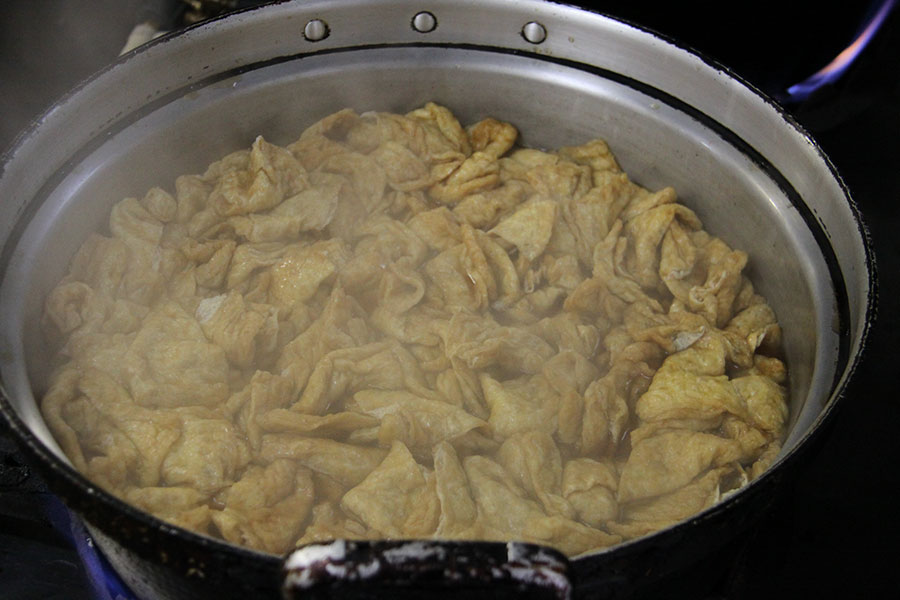
鍋の揚げの写真
[Photo: Fried pot] |

|
油抜きがすんだら、いよいよ油揚げを甘辛く煮て、味付けですね。
After removing the oil, the fried tofu is finally simmered in a sweet and salty sauce. |
|
|
| (吉益) |
水、砂糖、醤油、みりんで煮ていきます。
砂糖は白ざらめ、赤ざらめ、沖縄の黒糖の3種類を混ぜて使います。性質の違う3種の砂糖をブレンドすることで、奥行きの深い味になるわけです。そして、煮上がった油揚げは、汁に浸したまま3日置いてから使っています。
It’s simmered with water, sugar, soy sauce and mirin.
We mix three types of sugar: white sugar, brown sugar and Okinawan brown sugar. By blending three types of sugar with different characteristics, we produce a deep flavor. Then after the simmered fried tofu is left to marinate in the sauce for three days, it’s finally ready to use in the inarizushi. |
|
|
|
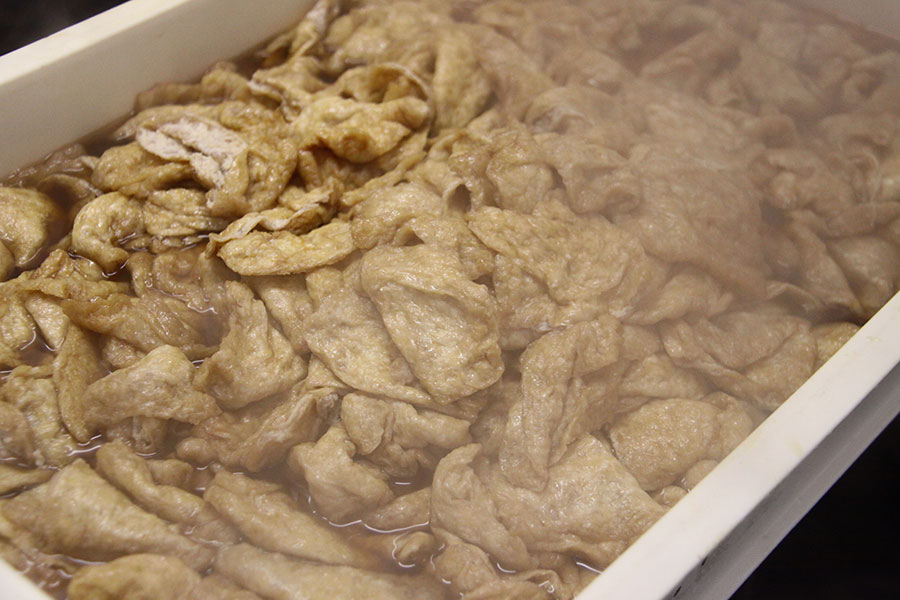
揚げの写真
[Photo: Deep-fried] |
|
|
 |
3日置くというのも、先祖伝来の知恵ですか?
Is marinating it for three days some technique passed down from previous generations? |
|
|
| (吉益) |
いや、父の時代までは、漬け込みは1日だったんです。私の時代で変えたんです。
No, before my generation, it was marinated for only for a day. I changed it after I took over from my father. |
|
|
  |
えっ!
Oh, really? |
|
|
| (吉益) |
創業の頃と今とでは、油揚げの材料の大豆も油も、また寿司飯の米も酢も違いますから、昔と同じようにおいしく食べていただくには、変えた方がよいところもでてくるんです。
Compared to when the shop was first established, the ingredients of the fried tofu such as soybeans and oil, as well as the rice and vinegar for the sushi rice are all different. For customers to be able to continue to enjoy the delicious flavors just as they did in the old days, it’s better that we make changes like this. |
|
|
 |
なるほど。では、おいしさのために、ほかの店のいなり寿司を食べ歩いて参考にするといったこともしていますか?
I see. So to get a feeling of the flavor, do you go around to other shops and try their inarizushi as a reference? |
|
|
| (吉益) |
いや、私は志乃多寿司の味を伝えていこうと思っていますから、他店のいなり寿司は一切食べません。食べれば知らず知らずのうちに影響される、流されると思っていますから。
No, I want everyone to know the taste of Shinodazushi, so I never eat inarizushi from other shops. If I do so, I think my sense of flavor will unconsciously be influenced. |
|
|
 |
一切、食べない!
Oh, you don’t eat other inarizushi at all?! |
|
|
| (吉益) |
今、いなり寿司や大阪寿司・箱寿司は昔ほど食べられなくなってきていますから、なかなか厳しい商売です。
でも、私は、お客様が「この寿司は、私の口に合わない、時代に合わない」と買ってくださらなくなったら、需要がなくなったら、もうそれでこの店は消えていいと思っているんです。
People these days don’t eat inarizushi, Osakazushi or hakozushi like they did in the past, so times are rather difficult. But for me, if customers don’t think that the sushi meets their expectations or is behind the times, they stop coming. And if there’s no demand, then it’s best for this shop to close its doors. |
|
|
 |
すごいですね。こういうのは、潔いと言ったらいいのかな。
That’s really interesting―so unwavering. |
|
|

| そういう江戸っ子らしさが、このスッキリとしたお寿司の姿や味にも表れているのかもしれませんね。
人形町は今も江戸時代を感じさせる下町情緒が残っていて、たくさんの人が、そんな街の空気にあこがれて遊びにきます。商店街も元気がよさそうですね。
I’ve heard that that was a characteristic of the old Tokyo folks, so I guess it’s only natural to see it in the sushi’s form and flavor.
Even now, the traditional downtown atmosphere of old Tokyo is alive and well in Ningyocho, and so that’s probably why so many people come here to enjoy that. The shopping streets look really lively here. |
|
|
| (吉益) |
それが、そうでもない。この街にも高齢化と少子化の問題が押し寄せていて、個人の店がどんどんやめているんです。後継ぎがいなければ、店は閉店せざるをえない。
それで、じわじわとチェーン店が増えてきています。
That’s actually not entirely true. This area also faces such problems of an aging population and declining birthrate, and private shops are closing down one after another. If they don’t have a successor, the shop has no choice but to close, and the number of franchise shops is gradually increasing. |
|
|

| ショックです…。
That’s quite a shocker. |
|
|
 |
今日は、どきっとさせられる話をいろいろ聞きました。おもしろかったし、勉強になりました。
でも、志乃多寿司のこの味が、なくなることはないですよ。だっておいしいから!
Today, I was able to hear a lot of really fascinating stories, and I learned a lot!
But the Shinodazushi sushi is too delicious to ever let go away―it’s amazing! |
|
|
  |
今日も、お客様がどんどんお店に入っていって、にぎやかですね。
忙しい時間にお話を聞かせていただいてありがとうございました。
It looks like again today things are getting busy with customers coming by one after another. Thank you very much for talking to us during such a busy time. |
|
|
|
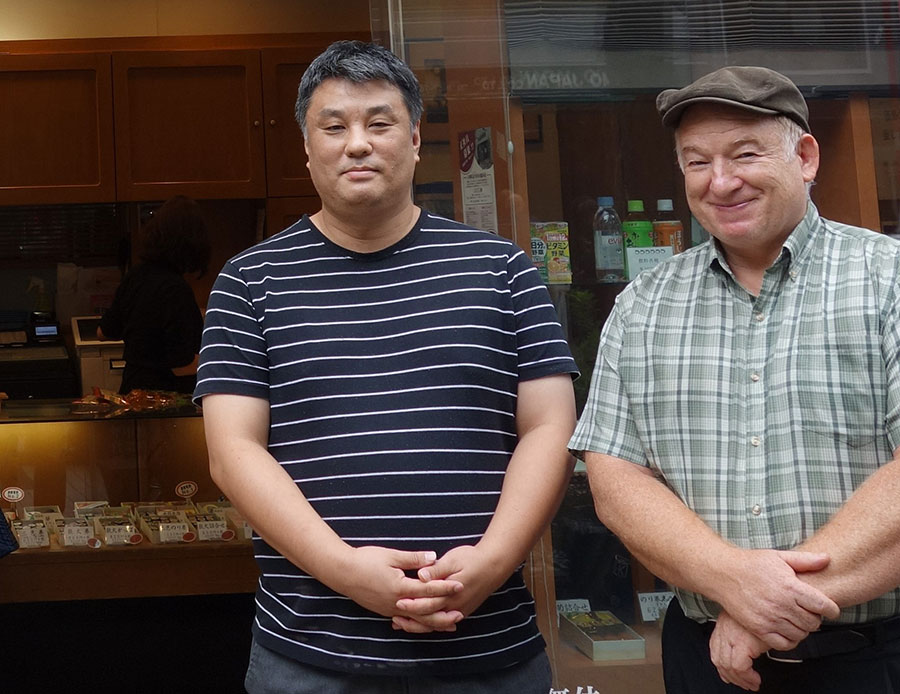
【記念撮影】
[Photo: Commemorative photo] |
|
|
|
(文)太田美代 (英訳)デイビッド・A・セイン |
 1959年、米国生まれ。証券会社勤務を経て来日し、翻訳・通訳など多岐にわたって活躍。豊富な教授経験を生かし、数多くの英語関係書籍を執筆。近著に『日本人のチョットへんな英語』(アスコム)、『超入門シャドーイング』(主婦の友社)、日本人が使いすぎる英語(PHP文庫)など多数。 下町の魅力に魅了され、自身が代表を務める英語関連のコンテンツ会社のエートゥーゼットのオフィスを根津に構えている。英会話本の執筆をしながら、東京・文京区根津と春日にあるエートゥーゼット英語学校の校長も務める。 http://www.smartenglish.co.jp/
1959年、米国生まれ。証券会社勤務を経て来日し、翻訳・通訳など多岐にわたって活躍。豊富な教授経験を生かし、数多くの英語関係書籍を執筆。近著に『日本人のチョットへんな英語』(アスコム)、『超入門シャドーイング』(主婦の友社)、日本人が使いすぎる英語(PHP文庫)など多数。 下町の魅力に魅了され、自身が代表を務める英語関連のコンテンツ会社のエートゥーゼットのオフィスを根津に構えている。英会話本の執筆をしながら、東京・文京区根津と春日にあるエートゥーゼット英語学校の校長も務める。 http://www.smartenglish.co.jp/













